Roman Republican Silver-Plated Coins
Silver-plated imitation denarii (fourreés) were a constant feature of the Roman Republic. Carter and Petrillo estimated that between 2 and 3 percent of all Roman Republican coins were plated fourreés. DeRuyter (NC 1996, p. 94) documents 11 plated coins of L. J. Bursio among a sample of 2300 (1/2 percent), including three plated pieces from "dies apparently identical to those of the official coins" [He intended to omit fourreés from his study, so obvious fourreés might not have been reported to him for analysis, causing the lower percentage he noted.]
Even an occasional quinarius is plated. The fraction of coins that are plated seems to be relatively constant -- there is no obvious epidemic period, and no period without plated pieces. The fineness of official Republican denarii was consistently on the order of 96-97%, so there was profit to be made in making plated imitations.
For a wonderful discussion of good-silver Roman Republican imitations from the region of Dacia, see Phil Davis's beautiful site: http://rrimitations.ancients.info/index.html But, be sure to come back here if you leave!
Some scans on this page are enlarged less than others. Regardless of image size here, all the denarius fourreés seem virtually normal size.
Coins are arranged chronologically.

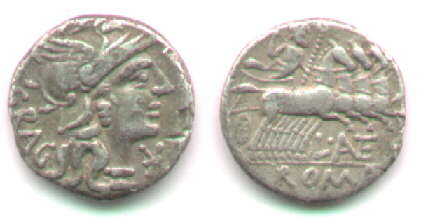
136 BC. Antestia 9. L. Antestius Gragulus (Cr 238/1) plated piece and its prototype
Imitation: 18 mm. 12:00. 2.69 grams. Prototype: 17 mm. 2:00. 3.72 grams.
Roma head right/Jupiter in quadriga right
Roma head right, GRAG downwrards
/Jupiter in quadriga right, L NTES ligate. ROMA in exergue
 17 mm. 6:00. 2.95 grams
17 mm. 6:00. 2.95 grams
134 BC. Aburia 1. C. Aburi Gem (Cr 244/1)
Roma head right, GEM behind
/quadriga right, driven by Mars with trophy in right, holding reins, spear and shield in left
CAB VI below, ROMA in exergue
Superb style (hardly distinguishable from the official coins) and excellent condition. Copper shows at the break at 4:00 on the reverse.
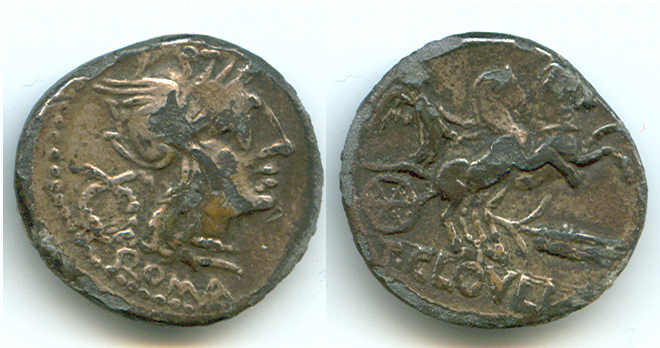
128 BC. T. Cloulius. Crawford 260. Sear 1.136. Cloulia 1
19 mm. 12:00. 3.20 grams.
Roma head right, wreath behind, ROMA below.
Victory in biga right, horses rearing. Wheat ear below. T CLOVLI in exergue.
Plating broken in places along the ear, helmet, and neck on the obverse, and barely broken on the reverse -- perhaps on the wheat ear and horse.
 19 mm. 3:00. 2.74 grams.
19 mm. 3:00. 2.74 grams.
122 BC. Minucia 1. Q. Minicius Rufus (Cr 277/1)
Roma head right, RVF downwards before
/Dioscuri on horseback, right, Q MINV below, ROMA in ex.
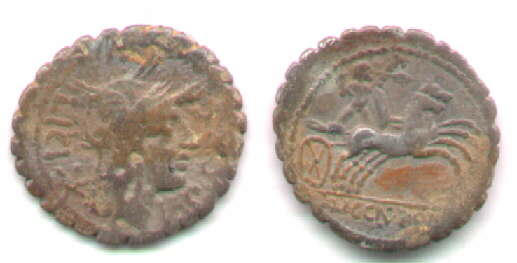 21-20 mm. 4:30. 3.74 grams.
21-20 mm. 4:30. 3.74 grams.
118 BC. Porcia 8. L. Licinius Crassus (Cr 282/5)
Serrate core of a silver-plated counterfeit, with all the silvering gone.
Roma head right, L PORCI - LICI (counterclockwise from 5:00)
/bearded warrior in biga, holding spear and carnyx and shield, L LIC CN DOM
Tacitus comments on the "native" preference for serrat bigtique.
This coin proves that serrations (notches, intended to serve as as pre-make test cuts) were not a guarantee against plated counterfeits.
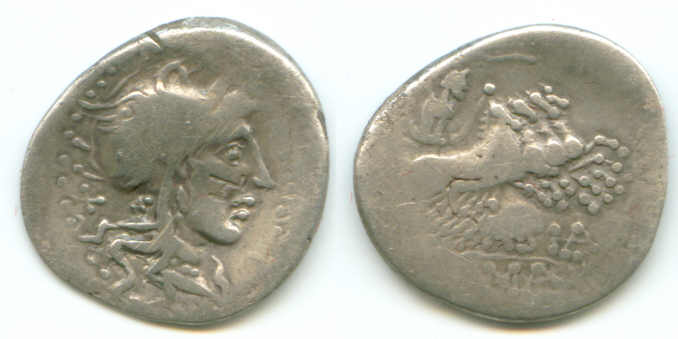 AR 21-19. 1:30. 3.66 grams.
AR 21-19. 1:30. 3.66 grams.
116 or 115 BC. Curtia 2. Q. Curtius with M. Sila. (Cr. 285) Sear 1.162.
Q. CVRT (very weak) upwards in front of the helmeted head of Roman right, X behind.
/Jupiter in quadriga right, with scepter and left and thunderbolt, M SILA (ligate) over ROMA in exergue.
This coin is problematic. I think it is one of the "Dacian" or "Balkan" imitations in good metal. Another expert thinks the whole issue is in poor style and this one, although extreme, is not so extreme as to assure it is not official.
Another Reference: Warsaw 496-502, of which 503 is fourree.

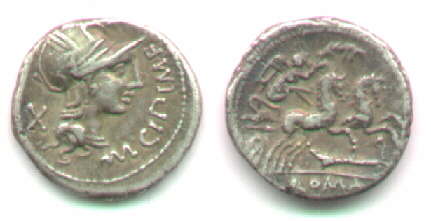
115-114 BC. Cipia 1. M. Cipius M. F. (Cr 289/1) plated piece and its prototype
Imitation: 17 mm. 6:00. 2.95 grams. Prototype: 17 mm. 5:00. 3.42 grams.
Roma head right, M CIPI M F in front
/Victory in biga right, rudder below, ROMA in ex.
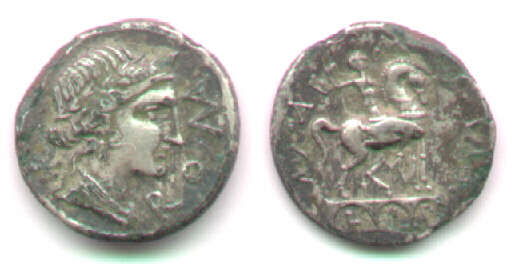 18mm. 12:00. 2.93 grams.
18mm. 12:00. 2.93 grams.
114 or 113 BC. Aemilia 7. Cr. 291.
laureate female head right (Roma?), draped and wearing diadem. ROMA before, upwards. * behind.
/equestian stature on 3 arches, in which L E P. Horseman holds vertical spear in right hand.
/AEM[I]LIO around 10:00-4:00.
Only the clear breaks on the edge that expose the copper core reveal this is silver-plated. Hardly visible on the scan, they are on the obverse at 10:00 and the reverse at 1:00. The style is quite good.

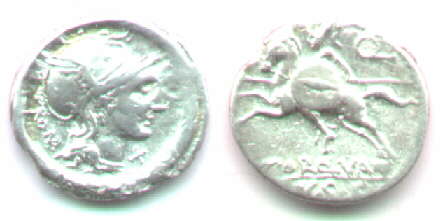
113-112 BC. Manlia 2. L. Manlius Torquatus (Cr. 295/1). Possibly a "limes" type which never had any silver and its prototype
Imitation: 18-17 mm. 6:00. 2.54 grams. Prototype: 18 mm. 6:00. 3.63 grams.
head of Roma right, torque as border
/horseman charging left with circular shield L TORQVA, in ex. EX SC
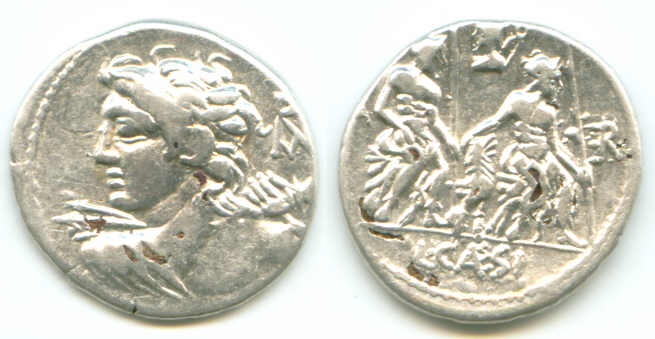 20 mm. 12:00. 3.33 grams
20 mm. 12:00. 3.33 grams
c. 112-111 BC. Caesia 1. L. Caesius. (Cr. 298) Sear 1.175.
Bust of Apollo left, seen from behind, with thunderbolt in right hand, monogram behind head
/Lares Praestites seated half right, with dog between, each holding staff in left hand. Above, bust left of Vulcan with tongs over shoulder.
Overcleaned and too shiny. A few thin breaks in the thick silver shell. The weight is light.

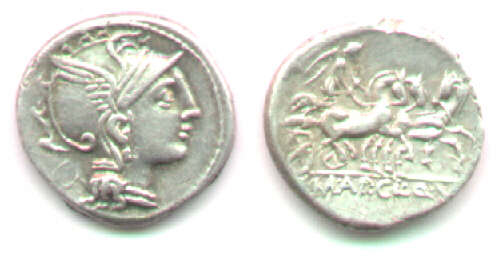
111 or 110 BC. Claudia 2. Apius Claudius Pulcher or T. Manlius Mancinus (Cr. 299/1a)
Imitation: 18 mm. 4:00. 2.77 grams. Prototype: AR17-18. 5:00. 3.87 grams.
Perfect official style. Only the break in the silver and the unusual 4:00 die axis reveal that it is a fourreé.
Helmeted head of Roma right
/Victory in triga right
/AP CL TM QVR in exergue
Prototype: TML AP CL Q VR (some ligate) in exergue. Cr. 299/1b
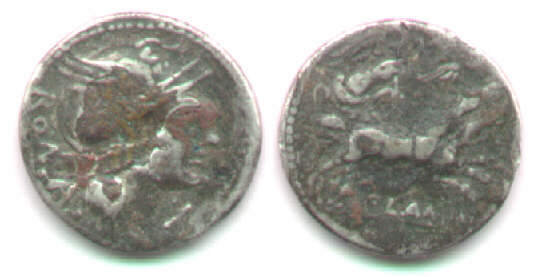 19 mm. 5:30. 3.04 grams.
19 mm. 5:30. 3.04 grams.
109 or 108 BC. Falminia 1. Cr. 302 (moneyer L. Faminus Chilo)
Helmeted head of Roma right; behind, ROMA
/Victory in biga right, L FLAMINI below, CILO in exergue.
The plating is badly broken over the head of Roma.
 19 mm. 3:30. 3.13 grams.
19 mm. 3:30. 3.13 grams.
104 B.C. C. Coelius Caldus. Coelia 2.
Helmeted head of Roma left.
/Victory in biga left, CALD below horses, control mark in exergue.
The obverse looks official. The weight is quite light.
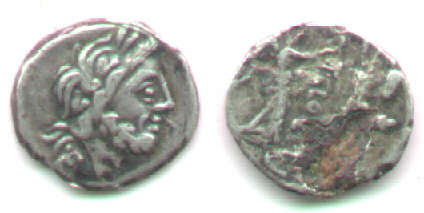
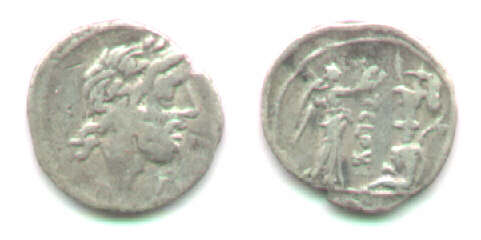
98 BC. Quinarius. T. Clovi Q. Cloulia 2b. (Cr. 332/1c). Sear M 212.
Imitation: 14 mm, 6:30, 1.55 grams. Prototype: AR16, 3:00. 1.75 grams.
Jupiter head laureate right
/T. CLOVI downwards between Victory right crowning trophy with captive below and carnyx (which identifes the trophy as Gallic)
[the bottom of the trophy and the captive are missing on this piece because of the plating has broken through there].
This coin has excellent style and convincing obverse silvering. Were it not for the broken plate, it would surely pass as official.


92 BC. Aelia 4. C. Allius Bala (Cr. 336/1c). 19-18 mm. 7:00. 3.21 grams.
Female head right, wearing diadem, BALA behind, L below chin
/Diana in biga of stags right, fly below, C.ALLI in exergue. Reverse with L/fly as attested on page 337 of Crawford.
This piece is in excellent style, with the reverse a tiny bit crude, but hardly more so than many Republican reverses. Only the very clear breaks in the silver show the base core of a fourreé. Examination at 20x shows there is a foil-like surface that has broken on these high spots. It is a fourreé.
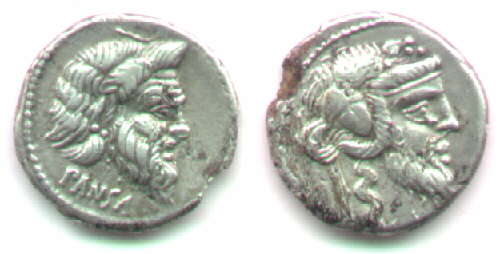 18 mm. 10:30. 3.34 grams.
18 mm. 10:30. 3.34 grams.
90 BC. Vibia 9. C. Vibius C. F. Pansa (Cr 342/2)
plated piece of superb style and nearly full silvering
Pan head right, PANSA below
/bearded Silenus head right, C VIBIVS C F below (off flan)
Crawford notes only two dies; it is very rare. I wonder if all specimens are actually plated. The style of this one is extremely close to the "official" ones pictured.
References: Banti, Vibia 22, 23d.
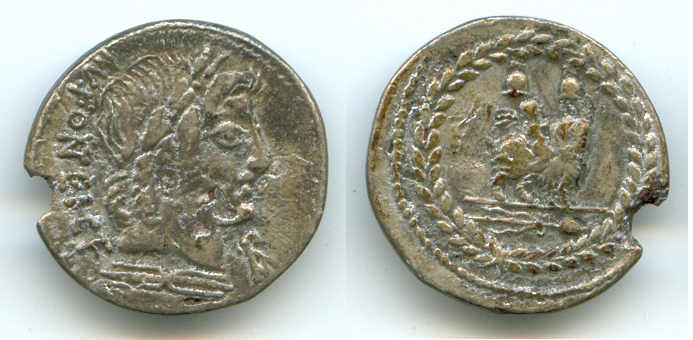
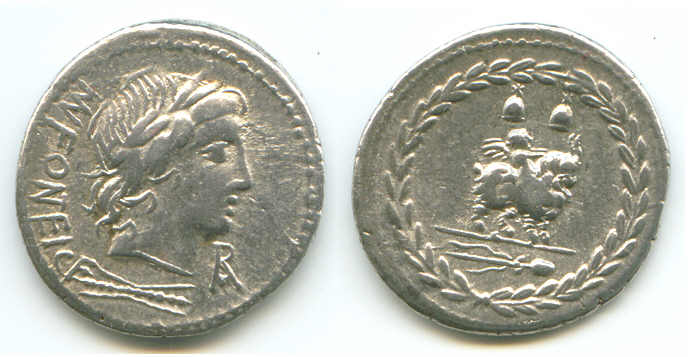
85 BC. Mn. Fonteius C.f. Fonteia 9-10a.
Imitation: 19 mm. 12:00. 2.91 grams. Prototype: 20 mm. 5:00. 3.80 grams.
MN FONTEI CF (some ligate) behind head of Apollo right with thunderbolt below
/cupid seated left on goat, pilei of Dioscuri above, thyrsus of Bacchus in exergue, all within laurel wreath.
This should weigh close to 3.9 grams. It is far too light.
Sear 1.271, Crawford 353/1.


83 BC. C. Norbanus. Norbana 2.
Imitation: 19 mm. 9:00. 2.38 grams (very light) Prototype: 19 mm. 7:30. 3.78 grams. Roman numeral: XXVIIII = 39
The reverse styles, strike, and condition would be convincing. The obverse legend is misspelled with two R's.
There is much obverse corrosion and the piece is far too light -- it should weigh about 3.9 grams.
[Roman numeral obscure, X visible] C NORRANVS, diademed head of Venus right. Should be NORBANVS as on the prototype.
/ear of grain, fasces with ax, caduceus
Sear 1.278. Crawford 357/1.
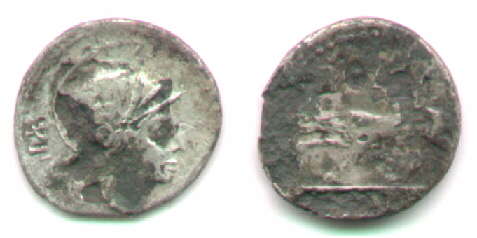 19 mm. 9:00. 2.26 grams.
19 mm. 9:00. 2.26 grams.
77 BC. Satriena 1. P. Satrienus (Cr 388/1b)
Roma head right, XI[IX] behind
/she wolf left, ROMA above, P SATRIE in ex.
very corroded
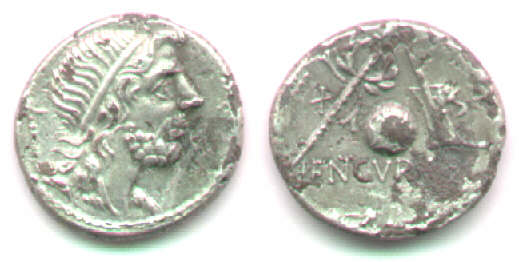 18 mm. 12:00. 3.37 grams.
18 mm. 12:00. 3.37 grams.
76-75 BC. Cornelia 55. LENT CVR DEN FL (Cr. 393b)
bust right of the Genius of the Roman people, bearded with scepter behind
/EX SC divided by globe between scepter and rudder
/LENT CVR [*FL] below
Cn. Lentulus was later consul in 56. The prototype was struck in connection with the war against Sertorius and the moneyer was Pompey's paymaster to troops in Spain.
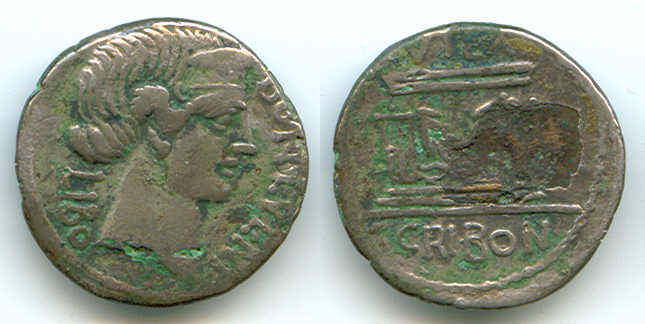
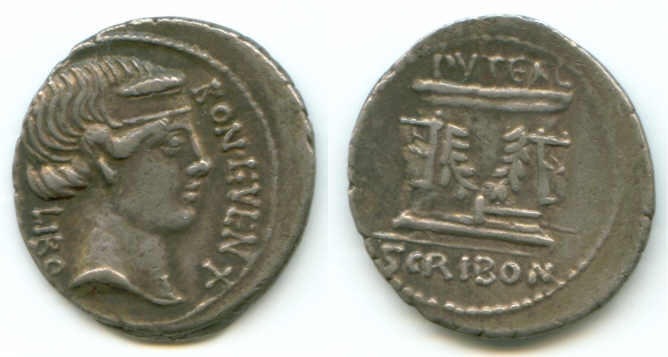
62 BC. L. Scribonius Libo. Crawford 416/1. Sear 1.367. Scribonia 8.
Imitation: 18 mm. 6:00. 2.88 grams. Prototype: 20mm, 6:00. 3.81 grams.
Head of Bonus Eventus right, BON EVENT downwards before, LIBO downwards behind neck.
Puteal Scribonianum (a waterwell head) decorated with garland and two lyres. PVTEAL above, SCRIBON below.
Obverse plating almost intact. Large flake missing from reverse.

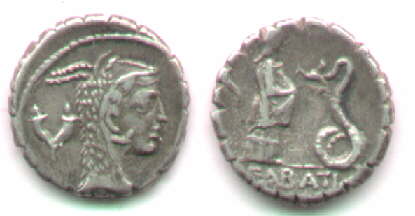
59 BC. Roscia 3. L. Roscius Fabatus (Cr 412/1 "64 BC") plated piece and its prototype
Imitation: 17 mm. 6:00. 2.37 grams. Prototype: 17 mm. 7:00. 3.95 grams.
head of Juno Sospita right in goat-skin headdress, double cornucopiea behind
/girl and large snake face each other, FABATI in exergue
Hersch and Walker ANSMN 29 (1984) redate this issue to 59 BC (from Crawford's 64 BC).
Note that both the imitation and the official piece have thin, shallow, knife-like serrations.
This piece shows that even serrate coins can be plated.
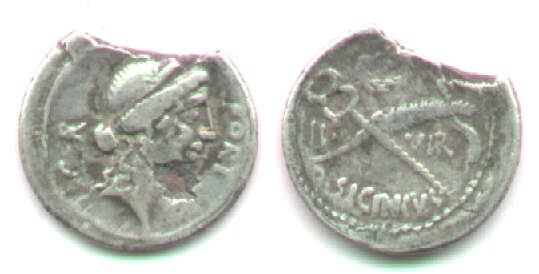

49 BC. Sicinia 5. Q. SICINIUS IIIVIR (Cr. 440) plated piece with a broken edge which reveals the thin silver plate over the base core.
19mm. 12:00. (Yes, I know I need better imaging capabilities for shots of edges.)
P R FORT (downwards in front). Head of Fortuna Populi Romani wearing diadem
/palm branch tied with fillet and winged cadeuceus in saltire, wreath above, below, Q SICINIVS, on either side III VIR
"The type alludes to the hopes of the Republican side at the beginning of the Civil war." -- Crawford, p. 460


41 BC. RSC "Mark Antony and Augustus" 8, page 128. Cr 517/2 "mint moving with Antony."
Imitation: 18-17 mm. 3:00. 2.97 grams Prototype: AR20. 1:00. 3.54 grams.
Darkly toned with breaks only on the Antony side.
M ANT IMP AVG IIIVIR RPCM BARBAT QP [good style, some letters weak or missing], head of Antony
/CAESAR IMP PONT IIIVIR RPC, [some letters off the small flan], head of Octavian
Prototype: Sear M. 1504. RSC 8, page 128.ation shows flaking at the surface. However, the interior seems granular and not coppery. The weight is light. I entertain the possibility that this is official with corrosion and silver-separation.
Silver Content of Republican coins
D. R. Walker, in "The silver contents of the Roman Republican coinage," (Metallurgy in Numismatics I (1980) pp.55-72) analyzed the silver content of almost 2000 Republican silver pieces and found that denarii had their silver content remarkably precisely controlled. From 211-169 BC 51 coins averaged 96.2%, from 169-101 504 coins averaged 97.7%, from 101-81 59 denarii averaged 96.7%, and from 82-62 the mean was 95.9% with an improvement in 62 to 97% and a predictable drop in the period 48-41 of civil war to about 95%. The legionary denarii of Marc Antony had mean about 92% (not as low as some have thought), with occasional pieces falling to 87.5%. They survived to the third century "because their silver content when worn was not far removed from the denarius of the Vespasianic standard, which continued to be employed at the mint of Rome until the middle of the second century."
The variation was tightly controlled. For example, in the period 169-101, of the 504 coins analyzed, the mean was 97.7% and only 6 pieces fell below 95% fine.
The quinarius was not so fine. Struck in large numbers from 101-87, it was about 94% fine.
References:
Crawford, Michael. Roman Republican Coinage, two volumes, 1974, Cambridge University Press.
Carter and Petrillo, "Silver-plated coins of the Roman Republic" in Rassegna di studi del civico museum archeologicl e del civico gabinetto numismaticao di milano, anno 1988, fasc. XVI-XLII, pp. 27-33.
DeRuyter, P. H., "The denarii of the Roman Republican money Lucius Julius Bursio, a die study," NC (1996) 79-147 and plates 21-22.
D. R. Walker, "The silver contents of the Roman Republican coinage," Metallurgy in Numismatics I (1980), edited by D. M. Metcalf and W. A. Oddy, pp.55-72.
Continue with the page on imitations of Roman Republican AE.
Return to the main page on imitations.
Go to the Table of Contents for other pages on ancient coins, not on imitations.






 AR 21-19. 1:30. 3.66 grams.
AR 21-19. 1:30. 3.66 grams.




 20 mm. 12:00. 3.33 grams
20 mm. 12:00. 3.33 grams





















